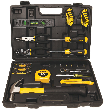Do you want to make your room a little larger? Perhaps you want to add a new walk-in closet, or a new window? Well, if you want to do any of these, or any number of other simple building projects, you will need to first remove a wall. While you may not need to remove an entire wall, the principles are generally the same. Here are some simple guidelines that you can use to make sure that you go about removing a wall safely, and without making more work for yourself.
One word of caution that you should pay attention to before you begin. Do not begin removing a wall without checking to make sure that it is a load bearing wall. If the wall is indeed a load bearing wall, certain precautions will need to be taken. The steps and guidelines listed here are based on the assumption that you are not working on a load bearing wall.
- Shut off the power. Since you will be cutting into, and removing a wall, you want to make sure that you do not accidentally get electrocuted. Shut off the power to the room you are working on, and as you come across any electrical lines be careful that you do not damage them.
- Remove the trim. Go around the wall, and begin removing the trim. This is usually the baseboards, door trim, chair rails, and any other pieces that are not specifically part of the wall itself. The best place to start is usually near a door, and working your way around the room. Use a hammer and a pry bar to remove the trim from the walls. If you want to reuse the trim once you are finished, make sure that you do this gently so you do not ruin the trim work, and remove all the nails.
- Open your wall. Take a small three pound sledge hammer, or even a regular claw hammer, and make an initial hole in the wall you are going to be removing. This hole will allow you to begin removing the drywall, and check to ensure that you do not accidentally damage or cut any electrical wiring.
- Remove the drywall. Demolition work is already difficult enough as it is, so you don't want to spend a lot of time doing clean up. Make your job easier by inserting a flat backed garden spade into your initial hole, and using it to "pull" out large sections of the wall. These pieces will be larger, and easier to clean up, than the smaller pieces that you would get from breaking the wall with a hammer.
- Cut and remove studs. Using either a handsaw or a reciprocating saw, begin cutting into the studs of your former wall. This will make removing the studs a lot easier. Once you have cut the studs at the halfway mark, begin wiggling them out of line. This will help loosen them from the top and bottom plates. If necessary, use a pry bar to help remove the studs the rest of the way. Be careful that you do not cut into any studs that you do not want removed.
- Remove top and sole plates. After you have removed the studs, you still need to remove the top and bottom plates. The easiest way to do this is to make two cuts into the top and bottom plates, about three inches apart, and then knocking that piece out. With this piece gone, the pressure on the remaining pieces has been lessened considerably. Use a pry bar to remove the remaining pieces of the plates.
Author Bio
Lee Wyatt
Contributor of numerous Tips.Net articles, Lee Wyatt is quickly becoming a regular "Jack of all trades." He is currently an independent contractor specializing in writing and editing. Contact him today for all of your writing and editing needs! Click here to contact. Learn more about Lee...
Homemade Christmas
Are you looking for something other than Christmas from a box? Despite what many people think, there is nothing wrong ...
Discover More
Cleaning Concrete
Cleaning concrete is actually something that is easier to do than what many people believe. Whether you need to clean a ...
Discover More
Easter Flowers
In large part, Easter flowers are pretty much a matter of local tradition. That being said, there are four different ...
Discover More
More Home Improvement Tips
Reducing Interior Noise
If you happen to have an older home, or a home that has lots of hard surfaces, then you probably know what it is like to ...
Discover More
Installing Kitchen Cabinets
After a while, everyone wants to change the look of their kitchen. This typically entails the need to do some cabinetry ...
Discover More
Cabinet, Counters, and Storage Tool Kit
Some of the more important parts of the home are things like cabinets, counters and other types of storage spaces. As ...
Discover More

Comments